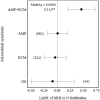Nitrogen Fertilisation Increases Specific Root Respiration in Ectomycorrhizal but Not in Arbuscular Mycorrhizal Plants: A Meta-Analysis
- PMID: 34421960
- PMCID: PMC8377726
- DOI: 10.3389/fpls.2021.711720
Nitrogen Fertilisation Increases Specific Root Respiration in Ectomycorrhizal but Not in Arbuscular Mycorrhizal Plants: A Meta-Analysis
Abstract
Plants spend a high proportion of their photosynthetically fixed carbon (C) belowground to support mycorrhizal associations in return for nutrients, but this C expenditure may decrease with increased soil nutrient availability. In this study, we assessed how the effects of nitrogen (N) fertiliser on specific root respiration (SRR) varied among mycorrhizal type (Myco type). We conducted a multi-level meta-analysis across 1,600 observations from 32 publications. SRR increased in ectomycorrhizal (ECM) plants with more than 100 kg N ha-1 applied, did not change in arbuscular mycorrhizal (AM) and non-mycorrhizal (NM) plants, but increased in plants with a dual mycorrhizal association in response to N fertilisation. Our results suggest that high N availability (>100 kg N ha-1) could disadvantage the growth of ECM plants because of increased C costs associated with maintaining higher root N concentrations, while the insensitivity in SRR by AM plants to N fertilisation may be because AM fungi are more important for phosphorus (P) uptake.
Keywords: association; carbon cost; expenditure; meta-regression; multi-level; multi-model inference; symbiosis; uptake.
Copyright © 2021 Bicharanloo, Cavagnaro, Keitel and Dijkstra.
Conflict of interest statement
The authors declare that the research was conducted in the absence of any commercial or financial relationships that could be construed as a potential conflict of interest.
Figures





References
-
- Atkin O. K., Edwards E. J., Loveys B. R. (2000). Response of root respiration to changes in temperature and its relevance to global warming. New Phytol. 147, 141–154. 10.1046/j.1469-8137.2000.00683.x - DOI
-
- Avis P. G., McLaughlin D. J., Dentinger B. C., Reich P. B. (2003). Long-term increase in nitrogen supply alters above- and below-ground ectomycorrhizal communities and increases the dominance of Russula spp. in a temperate oak savanna. New Phytol. 160, 239–253. 10.1046/j.1469-8137.2003.00865.x - DOI - PubMed
-
- Bache B. W., Chesworth W., Chesworth W., Gessa C., Lewis D. T. (2008). “Bulk density,” in Encyclopedia of Soil Science, ed W. Chesworth (Dordrecht: Springer Netherlands). 10.1007/978-1-4020-3995-9_80 - DOI
-
- Borenstein M., Hedges L. V., Higgins J. P. T., Rothstein H. R. (2009). Introduction to meta-analysis. John Wiley & Sons, Ltd 10.1002/9780470743386 - DOI
Publication types
LinkOut - more resources
Full Text Sources
Research Materials

